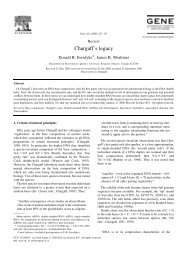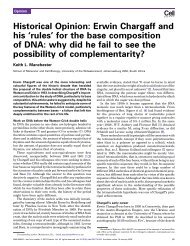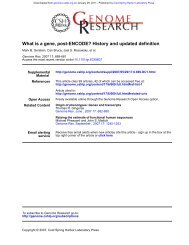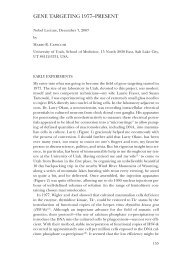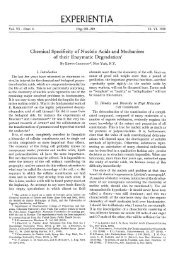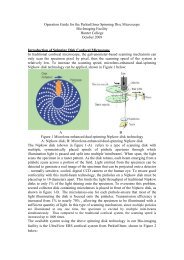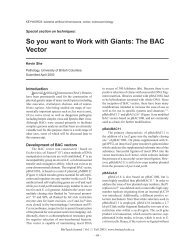Cold Spring Harb Symp Quant Biol-1953-Watson-SQB ... - Biology
Cold Spring Harb Symp Quant Biol-1953-Watson-SQB ... - Biology
Cold Spring Harb Symp Quant Biol-1953-Watson-SQB ... - Biology
You also want an ePaper? Increase the reach of your titles
YUMPU automatically turns print PDFs into web optimized ePapers that Google loves.
Downloaded from symposium.cshlp.org on March 26, 2009 - Published by <strong>Cold</strong> <strong>Spring</strong> <strong>Harb</strong>or Laboratory Press<br />
126 /. D. WATSON AND F. H. C. CRICK<br />
which are attached to a bonded pair of bases, must<br />
always occur at a fixed distance apart due to the<br />
regularity of the two backbones to which they are<br />
joined. The result is that one member of a pair of<br />
bases must always be a purine, and the other a<br />
pyrimidine, in order to bridge between the two<br />
chains. If a pair consisted of two purines, for example,<br />
there would not be room for it; if of two<br />
pyrimidines they would be too far apart to form<br />
hydrogen bonds.<br />
In theory a base can exist in a number of tautomeric<br />
forms, differing in the exact positions at<br />
which its hydrogen atoms are attached. However,<br />
under physiological conditions one particular form<br />
of each base is much more probable than any of<br />
the others. If we make the assumption that the<br />
favored forms always occur, then the pairing requirements<br />
are even more restrictive. Adenine can<br />
only pair with thymine, and guanine only with cytosine<br />
(or 5-methyl-cytosine, or 5-hydroxy-methylcytosine).<br />
This pairing is shown in detail in Figures<br />
5 and 6. If adenine tried to pair with cytosine<br />
it could not form hydrogen bonds, since there<br />
would be two hydrogens near one of the bonding<br />
positions, and none at the other, instead of one in<br />
each.<br />
A given pair can be either way round. Adenine,<br />
for example, can occur on either chain, but when<br />
it does its partner on the other chain must always<br />
be thymine. This is possible because the two glucoside<br />
bonds of a pair (see Figures 5 and 6) are<br />
symmetrically related to each other, and thus occur<br />
in the same positions if the pair is turned over.<br />
It should be emphasized that since each base<br />
can form hydrogen bonds at a number of points<br />
one can pair up isolated nucleotides in a large variety<br />
of ways. Specific pairing of bases can only be<br />
obtained by imposing some restriction, and in our<br />
ADENINE o THYMINE<br />
0 5,1<br />
I I i i i i I<br />
FzcuR~. 5. Pairing of adenine and thymine. Hydrogen<br />
bonds are shown dotted. One carbon atom of eaeh sugar<br />
is shown.<br />
GUANINE o CYTOSINE<br />
i , i I I<br />
FIGURE 6. Pairing of guanine and cytosine. Hydrogen<br />
bonds are shown dotted. One carbon atom of each sugar<br />
is shown.<br />
case it is in a direct consequence of the postulated<br />
regularity of the phosphate-sugar backbone.<br />
It should further be emphasized that whatever<br />
pair of bases occurs at one particular point in the<br />
DNA structure, no restriction is imposed on the<br />
neighboring pairs, and any sequence of pairs can<br />
occur. This is because all the bases are flat, and<br />
since they are stacked roughly one above another<br />
like a pile of pennies, it makes no difference which<br />
pair is neighbor to which.<br />
Though any sequence of bases can fit into our<br />
structure, the necessity for specific pairing demands<br />
a definite relationship between the sequences on the<br />
two chains. That is, if we knew the actual order of<br />
the bases on one chain, we could automatically<br />
write down the order on the other. Our structure<br />
there]ore consists o] two chains, each o] which is<br />
the complement o] the other.<br />
IV. EVIDENCE IN FAVOR OF THE COMPLEMENTARY<br />
MODEL<br />
The experimental evidence available to us now<br />
offers strong support to our model though we<br />
should emphasize that, as yet, it has not been<br />
proved correct. The evidence in its favor is of three<br />
types:<br />
(1) The general appearance of the X-ray picture<br />
strongly suggests that the basic structure is<br />
helical (Wilkins et al., <strong>1953</strong>; Franklin and Gosling,<br />
<strong>1953</strong>a). If we postulate that a helix is present, we<br />
immediately are able to deduce from the X-ray pattern<br />
of Structure B (Figure 3), that its pitch is 34<br />
A and its diameter approximately 20 A. Moreover,<br />
the pattern suggests a high concentration of atoms<br />
on the circumference of the helix, in accord with<br />
our model which places the phosphate sugar backbone<br />
on the outside. The photograph also indicates<br />
that the two polynucleotide chains are not<br />
X



